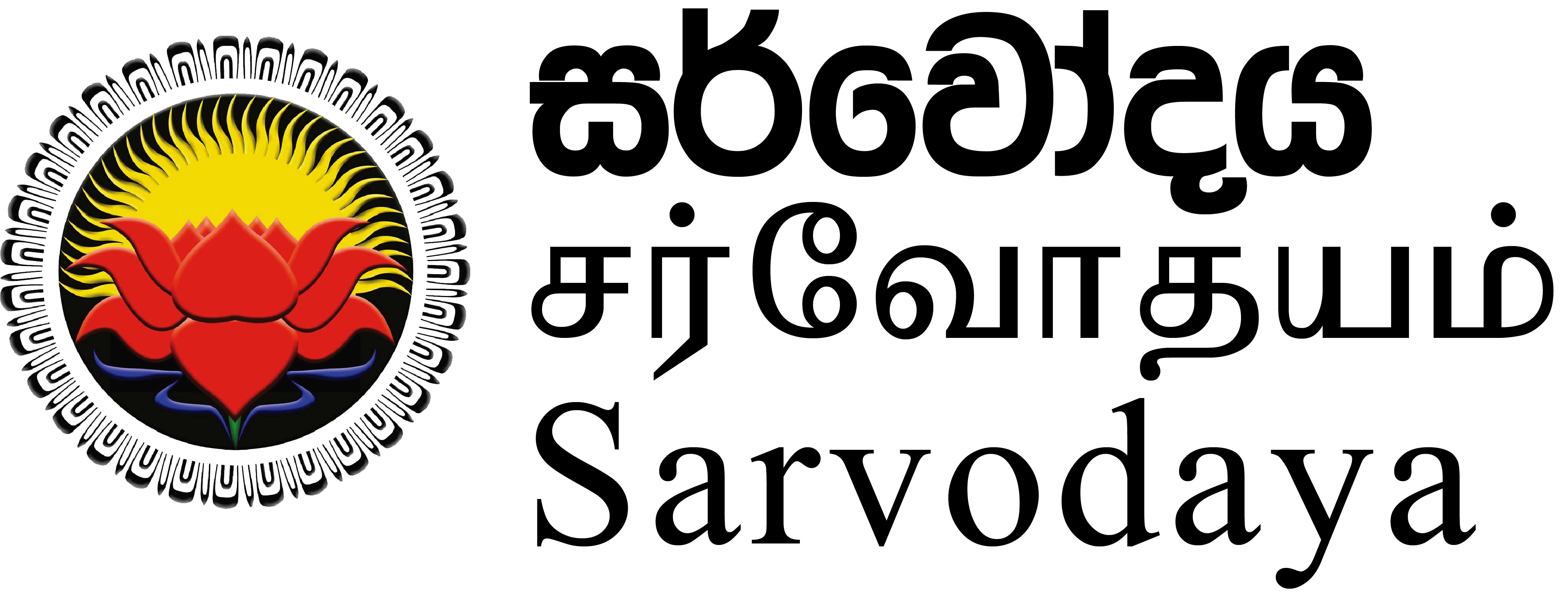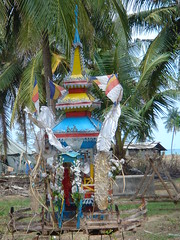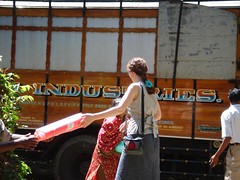The image at left is a Buddhist icon from Thailand which washed ashore near Batticaloa. The image at right is Fiona unloading goods from a truck in Kalmunai
Batticaloa Photo Gallery (68 photos) – Slideshow
Kalmunai Photo Gallery (117 photos) – Slideshow
This article is kindly written by Fiona Smith, a Doctor from the UK. It covers Batticaloa, Ampara and Kalmunai
I came to Sri Lanka to help as a volunteer with Sarvodaya in whatever capacity I could. My first task was to accompany a group of staff and volunteers led by Capt Jeevan Ariyaratne on a fact-finding mission to the East coast. We visited Batticaloa, Kalmunai and Ampara districts on the 7th to 9th February 2005. These Eastern provinces were some of the most heavily affected areas by the tsunami where over 13,000 people died. Over 60,000 houses had been destroyed leaving 150,000 refugees in 150 camps.
These districts are in the heartland of the area affected by the civil war and there was a significant military presence with army barracks and check-points. In addition to the new problems created by the tsunami there are a number of other difficulties to contend with such as landmines. Following the tsunami the landmines are feared to have shifted position and no one knows where they are now. We saw people living in previously cleared areas that were now taped off with landmine warning signs. Fortunately we heard no reports of anyone having been injured by any explosions yet – but this is a problem that needs to be addressed.
Our team visited Sarvodaya operated refugee camps as well as those run by International NGOs to coordinate and identify priority areas for Sarvodaya relief efforts. We also visited established Sarvodaya villages which had been completely devastated by the tsunami. Meetings were held with the district co-ordinators and volunteers at the regional headquarters to assess the current situation and implement plans for continuing relief efforts.
The scenes of devastation along the coast felt somewhat familiar to me from the extensive television coverage of the disaster, but nothing could have prepared me for the impact of being there in person. The sheer enormity of the damage is incomprehensible, and the fact that it extends for most of the Sri Lankan coast is beyond belief. One Sarvodaya village in Kalmunai district which had over 300 houses was totally decimated, the only traces of habitation left in that area were the health centre, some upturned wells, piles of rubble and torn shreds of clothing half buried in the sand. In another village more houses survived intact but the amount of destruction and rubble was enormous. Some houses were still inhabited despite only having half the original walls and crumbling foundations. Refugees were living in tents interspersed between the remains of houses.
The clearing-up process was underway but the enormity of the task ahead cannot be underestimated. There was a scheme in place called “cash for work” organised by Sarvodaya in partnership with USAID, which provided a small income for refugees to help clear up the land.
The current situation in the refugee camps we visited was much better than I had anticipated. The camps were incredibly well organised and there was no apparent shortage of tents, dry rations or medical aid. Adequate supplies of clean water were being provided and so far no reported epidemics of diseases such as cholera or dysentery had occured. This is a great achievement considering the huge number of people living in such close proximity.
An area of concern in the camps concerns sanitation. Some temporary toilets have been built but people from the coastal villages are not accustomed to using them so are using the jungle instead. This poses obvious sanitation risks as well as danger from landmines and snakes. Sarvodaya volunteers are involved with educating refugees about the importance of personal hygiene and encouraging people to at least allocate a specific area of jungle for toilet use.
There was an obvious and pressing need for psychological support and trauma counselling as many people were still in a state of shock and unable to carry out simple tasks such as cooking food, even though they had been provided with cooking equipment and dry rations.
Sarvodaya volunteers were already running play therapy programmes for children in the evenings, engaging them with music, games and art equipment. The children proudly showed me their pictures on the tent walls – not surprisingly big waves and destruction of homes featured in every drawing.
Sarvodaya’s main relief efforts in these provinces currently consists of water and sanitation provision, education services, social empowerment schemes and working closely with villagers to identify their needs in both the short and long-term. This is of utmost importance as many International NGO’s are only planning to stay for 6 months, whereas Sarvodaya support was in place before the tsunami and will remain afterwards. A volunteer programme called Heart to Heart already existed which links 2 separate regions of Sri Lanka. Volunteers from the unaffected linked regions are being sent in teams of 5 to 10 to spend 10 days at a time in refugee camps. They camp in the village and provide for themselves. Their role is to live and work with the refugee community and help rebuild the psycho-social infrastructure in these camps.
Coordinating the relief effort in these areas is a hugely challenging task for all involved. With the expert knowledge that the Sarvodaya staff and volunteers have from years of working in this region I was impressed by the projects they are engaged in and am sure they will have a hugely beneficial impact for these refugees.


